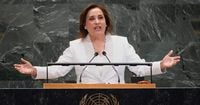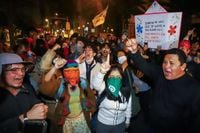Peru awoke on October 10, 2025, to yet another dramatic shift in its political landscape, as Congress voted overwhelmingly to impeach President Dina Boluarte amid a surging crime wave, immediately installing 38-year-old lawyer and Congress leader Jose Jerí as interim president. The move, carried out in the early hours of Friday morning, marked the seventh time in less than a decade that the Andean nation has changed presidents—a reflection of deepening instability and public frustration with governance.
The impeachment came after months of mounting criticism directed at Boluarte’s administration for its inability to stem a relentless tide of violence. According to official statistics cited by Reuters and the Associated Press, Peru recorded 6,041 homicides between January and mid-August 2025, the highest such figure since 2017. Extortion complaints soared to 15,989 between January and July—an alarming 28% increase compared to the same period in 2024. The tipping point, however, came just two days before the vote, when a gunman opened fire at a popular concert in Lima, injuring five people and sparking outrage across the country.
“This crime has been brewing for decades and has been strengthened by illegal immigration, which past administrations haven’t defeated,” Boluarte said during a military ceremony on October 8. “Instead, they’ve opened the doors of our borders and allowed criminals to enter everywhere... without any restrictions.” Her remarks, widely viewed as controversial, further alienated lawmakers and segments of the public, intensifying calls for her removal.
Congress wasted little time. On the evening of October 9, lawmakers debated four separate requests to impeach Boluarte, ultimately summoning her to defend herself before the 130-member unicameral legislature. When she failed to appear shortly before midnight, the chamber moved swiftly: 124 lawmakers voted to oust her, with no votes against and only a handful abstaining. The result was decisive, reflecting a rare consensus across Peru’s often-fractious political spectrum. As AFP and CTV News noted, eight previous attempts to remove Boluarte had failed, but this time, anger over crime and perceived governmental paralysis united nearly all factions.
Boluarte, who had become Peru’s first female president in December 2022 after the impeachment of her predecessor Pedro Castillo, addressed the nation on television following the vote. “I have not thought of myself, but rather of Peruvians,” she said, recounting her administration’s perceived achievements. But within minutes, the broadcast was interrupted to show Jerí’s swearing-in ceremony—a stark symbol of the abrupt transition.
Jerí, a relatively young but seasoned lawyer, had served as president of Congress prior to this sudden promotion. In his inaugural address, he pledged to defend Peru’s sovereignty and ensure a peaceful transfer of power to whoever wins the scheduled April 2026 elections. “I will defend Peru’s sovereignty and hand over power to the winner of the April election,” he declared, seeking to reassure a nation weary from years of political upheaval.
The roots of Boluarte’s downfall run deeper than any single incident. Her administration was beset by scandal and unrest from the outset. More than 500 protests erupted in the first three months of her presidency, many demanding her resignation and decrying the state’s response to demonstrations in support of her predecessor. Accusations swirled regarding alleged illicit profits, a high-profile scandal dubbed “Rolexgate” involving undeclared luxury gifts, and a controversial self-approved pay raise. Despite her denials of any wrongdoing, Boluarte’s approval ratings languished between 2% and 4%—among the lowest for any Peruvian leader in recent memory, reports Reuters.
Her partial attribution of the crime surge to illegal immigration did little to stem the tide of criticism. Many lawmakers saw the comments as scapegoating and lacking in substantive policy solutions. The country’s new wave of violence, punctuated by the Lima concert shooting, only heightened the sense of government impotence and urgency for change.
Prime Minister Eduardo Arana attempted a last-minute defense during a crime-focused hearing before Parliament on October 9. “Parliament’s concerns are not resolved by addressing a request for impeachment, much less by approving it,” Arana told lawmakers. “We are not clinging to our positions. We are here, and we knew from the beginning that our first day here could also be our last day in office.” But his words failed to sway the chamber, which appeared united in its determination to act.
Boluarte’s removal continues a pattern of rapid turnover at the top of Peruvian politics. She was the country’s sixth president in just under a decade, a period marked by repeated impeachments, corruption scandals, and widespread public mistrust. Normal presidential terms in Peru last five years, but few recent leaders have completed their mandates. The instability has eroded confidence in democratic institutions and complicated efforts to address the country’s pressing challenges.
For many Peruvians, the hope now rests on Jerí’s interim leadership to bring a measure of calm and order as the nation prepares for elections. His legal background and reputation for pragmatism are seen as potential assets in navigating the treacherous political waters ahead. He faces the daunting tasks of restoring public trust, curbing the crime wave, and ensuring a credible and peaceful electoral process next April.
Yet the challenges are formidable. The crime surge that catalyzed Boluarte’s impeachment has deep roots, tied to longstanding issues of poverty, inequality, and institutional weakness. Law enforcement agencies are stretched thin, and public frustration remains high. The political consensus that ousted Boluarte may prove fleeting, as competing interests and ambitions resurface in the run-up to the elections.
Still, Jerí’s swift assumption of the presidency and his stated commitment to a smooth transition have offered a glimmer of hope for a country battered by turbulence. As Peru stands at another crossroads, its citizens and leaders alike are left to wonder: will this latest change mark the beginning of genuine reform, or simply another chapter in an ongoing saga of instability?
Amid the uncertainty, one thing is clear—Peru’s future will be shaped by the choices made in the coming months, as a nation seeks both safety on its streets and stability in its halls of power.





